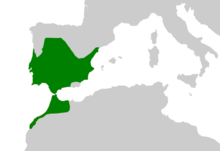Pleurodeles waltl
| Iberian ribbed newt | |
|---|---|
 |
|
| Pleurodeles waltl in an aquarium. | |
| Scientific classification | |
| Kingdom: | Animalia |
| Phylum: | Chordata |
| Class: | Amphibia |
| Order: | Urodela |
| Family: | Salamandridae |
| Genus: | Pleurodeles |
| Species: | P. waltl |
| Binomial name | |
|
Pleurodeles waltl Michahelles, 1830 |
|
 |
|
| Distribution in the Iberian peninsula and the Maghreb | |
| Synonyms | |
|
Pleurodeles waltlii (incorrect spelling) |
|
Pleurodeles waltlii (incorrect spelling)
The Iberian ribbed newt or Spanish ribbed newt (Pleurodeles waltl) is a newt endemic to the central and southern Iberian Peninsula and Morocco. It is the largest European newt species and it is also known for its sharp ribs which can puncture through its sides, and as such is also called the sharp-ribbed newt. This species should not be confused with the different species with similar common name, the Iberian (mostly Portuguese) newt (Lissotriton boscai).
The Iberian ribbed newt has tubercles running down each side. Through these, its sharp ribs can puncture. The ribs act as a defense mechanism, causing little harm to the newt. This mechanism could be considered as a primitive and rudimentary system of envenomation, but is completely harmless to humans. At the same time as pushing its ribs out the newt begins to secrete poison from special glands on its body. The poison coated ribs create a highly effective stinging mechanism, injecting toxins through the thin skin in predator’s mouths. The newt’s effective immune system and collagen coated ribs mean the pierced skin quickly regrows without infection.
In the wild, this amphibian grows up to 30 cm (12 in), but rarely more than 20 cm (7.9 in) in captivity. Its color is dark gray dorsally, and lighter gray on its ventral side, with rust-colored small spots where its ribs can protrude. This newt has a flat, spade-shaped head and a long tail, which is about half its body length. Males are more slender and usually smaller than females. The larvae have bushy external gills and usually paler color patterns than the adults.
P. waltl is more aquatic-dwelling than many other European tailed amphibians. Though they are quite able to walk on land, most rarely leave the water, living usually in ponds, cisterns, and ancient village wells that were common in Portugal and Spain in the past. They prefer cool, quiet, and deep waters, where they feed on insects, worms, and tadpoles.
Sex determination is regulated by sex chromosomes, but can be overridden by temperature. Females have both sex chromosomes (Z and W), while males have two copies of the Z chromosome (ZZ). However, when ZW larvae are reared at 32 °C (90 °F) during particular stages of development (stage 42 to stage 54), they differentiate into functional neomales. Hormones play an important role during the sex determination process, and the newts can be manipulated to change sex by adding hormones or hormone-inhibitors to the water in which they are reared.
...
Wikipedia

